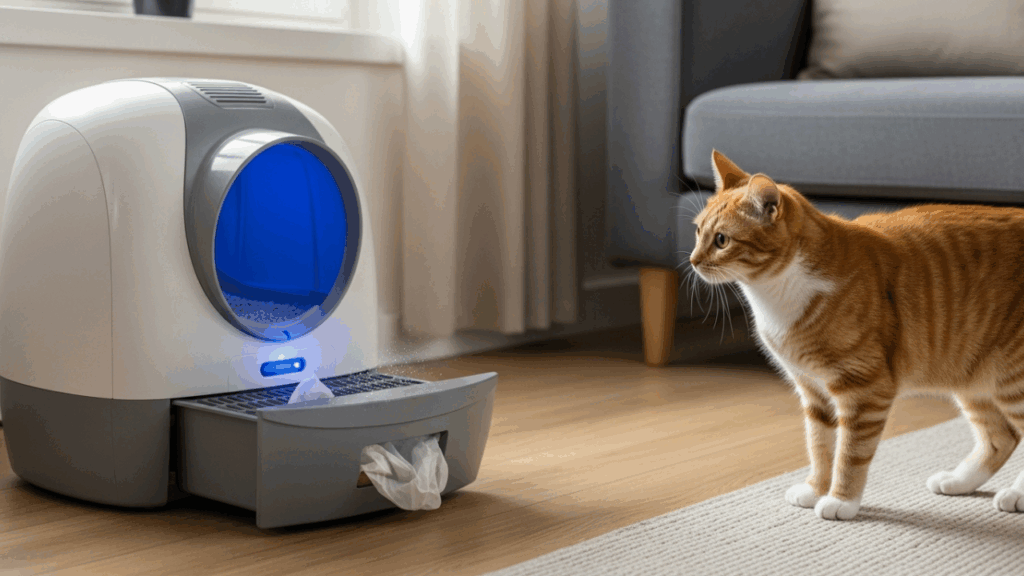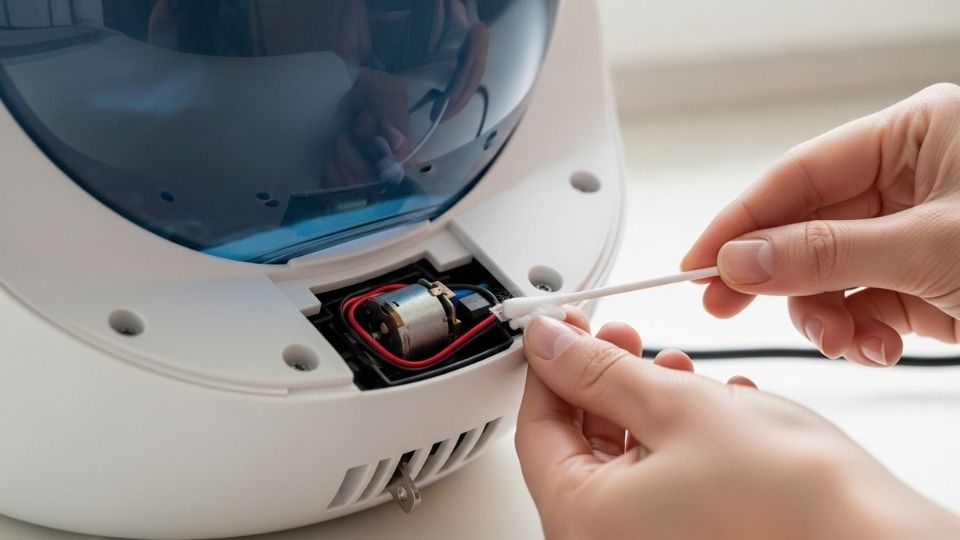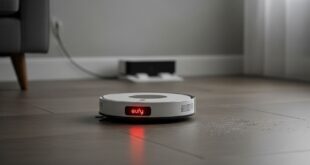You’re not alone. If you’re currently standing over your Litter Robot, watching a stubborn blue light blink at you while your cat bewilderedly circles around, you’re not alone.
Max here and I’ve been in your shoes too many times. That blinking blue light often decides to show up when you’re busiest. You’ve done the necessary cleaning, and it should be sitting pretty because the drawer has been double-checked and cleaned. But nope! It’s still blinking like a protest sign sent up by a contraption that was meant to simplify your life.
This guide is more than a technical fix—it’s part of a journey of solving a problem riddled with emotions. It goes without saying that pet parents understand the struggles attached. So I will patiently guide you through resolving the blinking light issue for good, while keeping your sanity intact.
Key Takeaways
- Resolving blinking errors begins with checking the waste drawer and liner position.
- Inaccurate readings caused by not-aligned or dusty sensors can be cleaned to solved so-called “dirty” errors.”
- Most logic bugs can be fixed by power cycling or pressing the reset button.
- For everything else, contact support or check the hardware yourself.
- To avoid these problems in the future, build a habit to regularly check the unit and daily ensure the drawers are clean.
First, Let’s Talk About Why It Happens
The reason why that blue light is blinking is not random. It is your Litter Robot trying to notify you of something important.
Most of the time, it signifies that the waste drawer is full. But here’s the twist: it might not actually be full.
Once in a while the drawer’s liner may be bunched up, or the drawer is not sitting properly. Other times the sensor is dirty and misaligned, which adds to the confusion.
It’s as though a puzzled cat is meowing at an incorrect pantry; as far as the cat is concerned, something is wrong, even if everything is totally fine on your end.
Now, this is not a design error. It’s simply how sensors work. They don’t operate like you or I do.
Your quiet day disrupted by blinking blue lights is caused by the not so bright sensors which only detect light bouncing off surfaces and use that light to guess what is present. Light reflecting oddly off the liner, or a speck of litter sticking to it in the wrong place could throw off the reading.
Empty The Drawer—But Do It The Right Way
Empty the drawer. But do it the right way. You might be thinking, “Max, I already emptied it!” I fully believe you. But for now, open the drawer completely and do not just remove it.
Now, let’s remove the bag. Look just under the plastic liner. Is there some litter underneath? Sometimes small bits either escape or the plastic liner tears at the bottom. Remove that area completely clean—if you need to, use a paper towel or a hand vacuum. After you are certain it is clean, place a fresh liner.
Here’s a hack most people do not get: make sure the liner is not hanging over the edge of the drawer.
If any part reduces the flow of its sensors, the blue light will continue blinking. Smooth the liner against the bottom of the drawer. Remove any folds or bumps. Push the drawer all the way in until it clicks and is flush with the rest of the unit. It should feel like the bottom drawer of a kitchen cabinet—aligned straight and not slightly open.
Now, and this is important, press the reset button. That’s a step you can’t skip. Your robot will appreciate a small boost to begin working again after all the changes you made. If all the steps were followed properly, it should stop blinking, and trust me, the moment it does is very satisfying.
What If The Light Is Still Blinking?
Let’s explore the rest of the ‘litter robot reset’ together. If after following instructions on resetting the drawer the light remains blinking, I like to refer to this point as the second circle of litter robot perplexity. Here, we slowly delve further but do not leap to conclusions.
The next thing you examine is the sensor region. As always, the drawer sensors will be situated near the base, close to where the drawer is meant to slide in.
Using a dry, soft cloth, wipe the sensor windows clean. Dust, litter residues, and even moisture can obstruct the sensor from reading correctly. It is like trying to see through fogged glasses. No sensor is capable of reading through debris.
Still blinking? Clean the inside tracks after removing the globe.
Although it might not be the direct cause of the blue light, too much litter build-up may add enough confusion to throw off the entire unit’s equilibrium. I once found a cat toy behind the globe that was stuck and was causing the rotation to be thrown off. You never know what kind of trouble your furry friend has gotten into.
Understanding Your Litter Robot’s Mind (Yes, It Has One)
This may sound strange, but your Litter Robot does have a sort of “mind.” It uses a control board to help it process simple logic to know when to rotate, when to stop, and when to signal an error. In the case where there is blinking without obvious drawer or sensor issues, we could be looking at a software confusion loop.
Turn off the unit and unplug it. Leave it off for two minutes and then plug it back in. Restarting resolves many issues, along with resetting an internal state. After rebooting, press the reset button once again. I understand this step feels too simple, but I have seen it work after trying everything else.
This type of “mental reset” is ideal before seeking outside assistance. It’s akin to switching phones off and on—clearing unnecessary data in the system. No tools are required, no tech support needed—just patience and power cycling.
What If It’s A Hardware Problem?
This is where things get more serious. If every attempted fix has been futile and the blinking blue light returns the next day or, even worse, stays permanently, you might be dealing with a hardware problem. While that does sound scary, it’s not the end of the world. I’ve dealt with this before and in most cases, it is still manageable without having to replace the entire unit.
The pinch sensors, for instance, can fail. These are tiny pressure gauges located close to the globe’s base that help the unit decide when it’s safe to rotate. If these sensors fail, they could misidentify a normal drawer as a full one. Alternatively, the sensor contacts within the base might be oxidized or loose. If you are willing to open the base cover (make sure the unit is powered off), you can do minor touch-up repairs by washing the sensor contacts with isopropyl alcohol and cotton swabs.
After a move, I once had to reposition the wires that run under the drawer because they had shifted. It was easy—just a matter of closely examining things and giving them a small nudge. No need for soldering or replacements, just gentle fixes and observation.
The Last Resort: Call For Help (It’s Not Giving Up)
Occasionally, no matter what you do, the blinking won’t go away. That’s when you reach out to Litter Robot’s customer support. You are not failing when you seek assistance. You are simply allowing the device to be properly evaluated. Which, in fact, they do.
Prepare to explain everything you have already done that saves you and your time and effort.
Have your steps done, tell them the blinking pattern, and describe the steps you have done.
Mention odd noises, smells, or behaviors. I’ve had them walk me through advanced troubleshooting via email and once, they sent me a part without charging.
They understand that cat parents do not want to play mechanic every other day. For this reason, their support team is available.
Keeping It From Happening Again
Let’s discuss how to ensure the blinking light never comes back. I’m confident you don’t want to go through this more than once, so let’s aim for getting it right the first time.
It begins with a straightforward practice—check the drawer once every morning. Make it part of your routine, like brushing teeth—emptying it ensures full sensor preemption.
Weekly routine cleaning of the unit with damp cloths, gentle cleaners, and special care for the sensors is a must.
Change the liner correctly every single time. Make sure it is straight and not bunched up on the sides. Also, don’t overfill the litter itself; just enough to hit the fill line. It can clog everything if too much litter gets into the base.
Keep your Litter Robot on a flat surface. Slopes or tilts confuse the balancing logic. If you move it, make sure all parts clicked back into place before using it again.
A Quick Word About The App
Do not overlook alerts from Litter Robot app, as it often notifies you of issues prior to the unit itself.
The app malfunctioning alerts like “the drawer is full” when it’s not indicates there is a problem that needs attention. Your app can act as an early detection system for issues which can be resolved earlier and avoid attending to emergency my-cat-needs-to-go midnights.
My Words
It’s Max again. I can relate to the story, I also tried to solve things on my own and spent countless hours wondering in front of screens.
The blinking blue light does not indicate failures. Rather, it should be perceived as communication because there is a specific way to interpret and act upon it, and in turn regain your control over the device.
So, deep breaths to whoever you are with a screwdriver in one hand and cat under the bed or behind you. Things will get better, one change at a time.
 RapTijd
RapTijd



